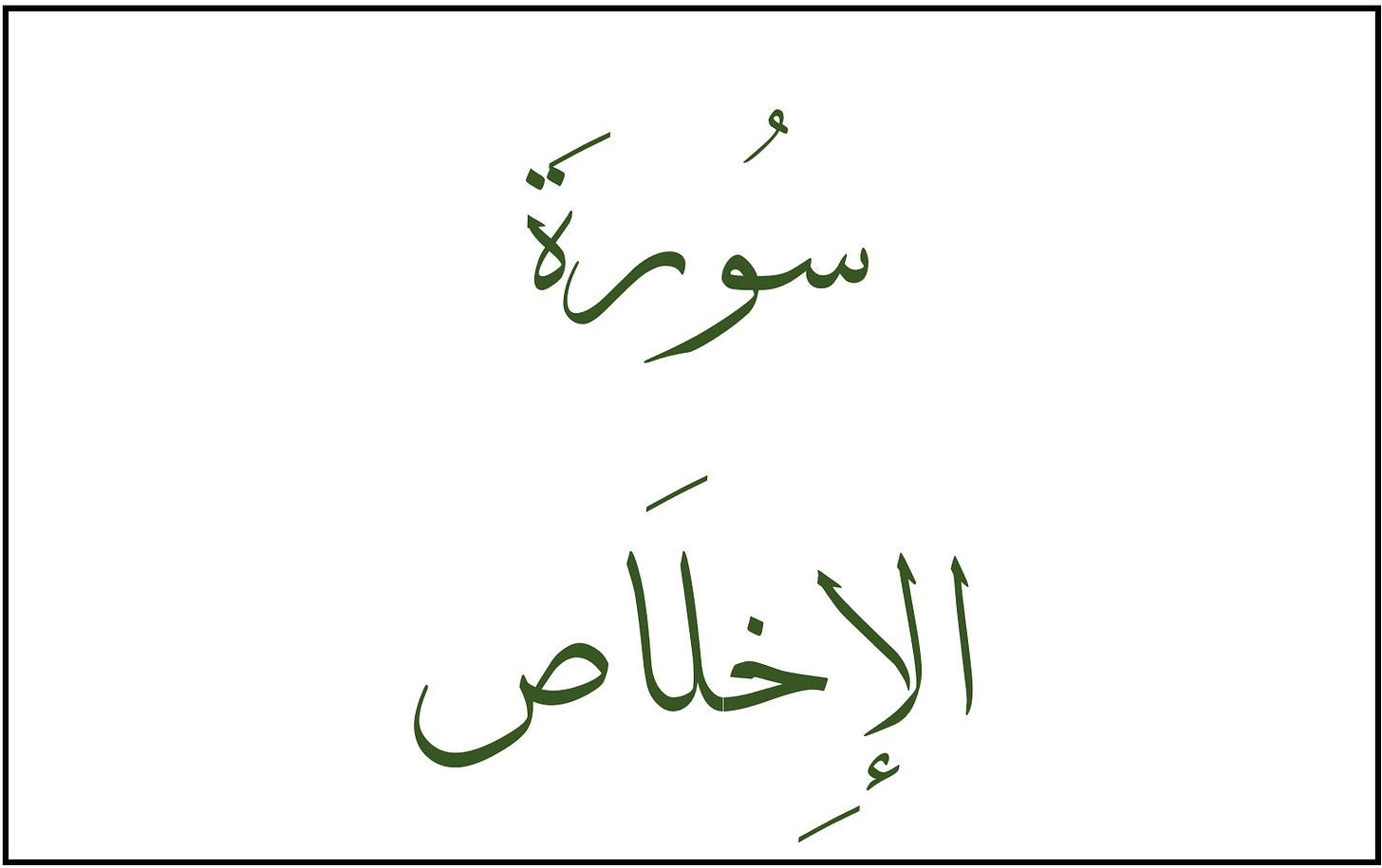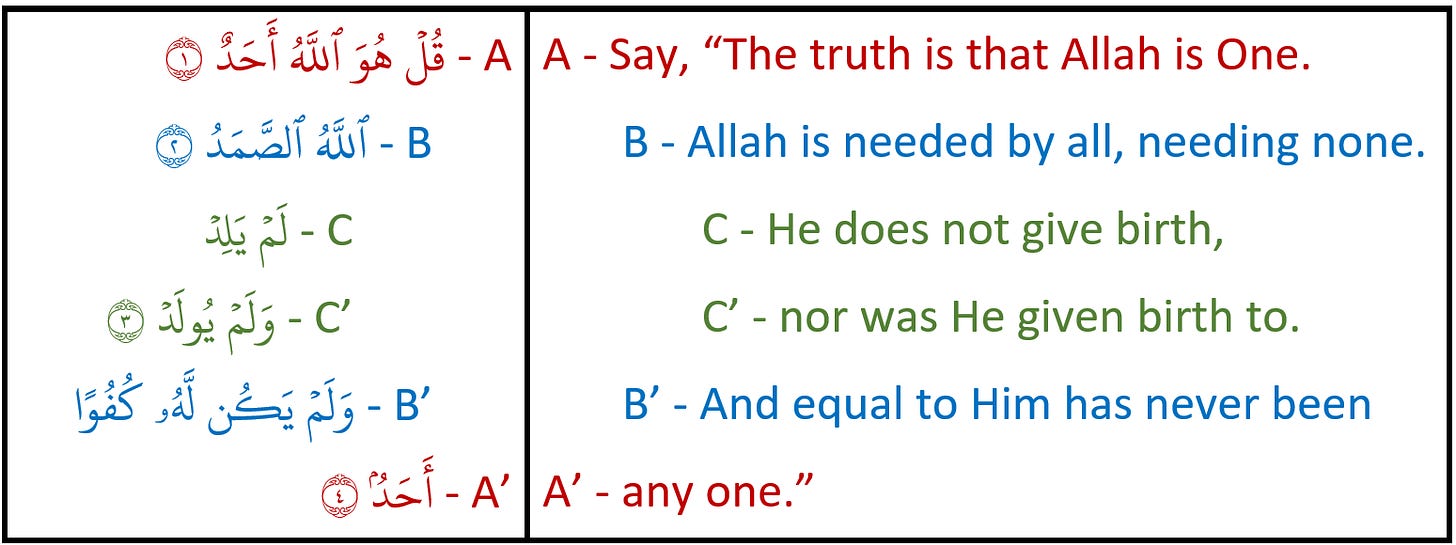Sūrah al-Ikhlāṣ - Revisited
A look back at Sūrah al-Ikhlāṣ and general reflections on Quranic structuring
Many months ago, we published a post on the ring structure of Sūrah al-Ikhlāṣ. One of our readers, Omer Abid, commented with their own thoughts on the structuring which we thought were worth sharing. Abid proposed an alternate ring structure to the one we presented, but we actually think it’s better than our original.
Our previous structuring is reproduced below. See the original post to understand the connections in more depth.
Abid’s structuring is as follows:
Connections
[A]/[A’] - The sūrah begins by declaring Allah’s complete oneness and uniqueness. Though one might ask, “Are there others like Him, equally unique in their own right?” to which Allah ﷻ responds in the negative with the last āyah.
[B]/[B’] - The second āyah deals with Allah ﷻ being eternal in the future. But one might ask, “What about the past?” to which Allah ﷻ responds with the second half of the third āyah. He has no beginning, and thus is eternal in the past as well.
[C] - The center is a succinct summary of both outer sections. Unlike all His creation, Allah ﷻ does not need something to succeed Him as we do. This makes Him unique from all that is created and emphasizes His eternal being.
Thoughts on Quranic Structuring
Not for the first time, we have gone back and revisited the structure of a sūrah we’ve already covered. Does this mean we got it wrong? It’s very possible, but we would like to propose another theory.
When one searches the meaning of the Quran in tafsīr (works of scholarly interpretation), it is common to come across multiple definitions and explanations of a single word. What scholars will tell you is that often these differences of opinion are not contradictory, but rather, complementary. Each may in fact be correct and lends to the depth of the Quran’s meanings.
This is clearly seen in the translations of the two structures above. One translates Aṣ-Ṣamad as “needed by all, needing none” and the other as “the Eternal.” While completely different, they are both valid.
Similarly, maybe Quranic structuring is the same way. Is it be possible that the depth of Allah’s words allows for there to be more than one way to organize them? And that each new structuring gives us a different perspective on the text? This is the theory we ascribe to.
So it is not that one structuring is wrong, rather, that there are multiple, overlapping structures that all demonstrate the depth and complexity of Allah’s word.
What Makes Quranic Structuring Special?
A reader once asked us, “Can we claim that the ring composition is a miracle that proves that the Quran is the book of Allah? Or can we not because it was already available in poems and other manuscripts before Islam?”
That is a great question, but one that needs framing. We could write a ring composition in this post, but no one would think it's miraculous, so it's not the structure alone that amazes. Also, there are some suwar which seem to demonstrate a parallel structure, not a ring structure, so it is not true of the entire Quran anyways.
We think that when you consider how the Quran was revealed, it provides a much clearer picture of the miracle we are witnessing.
The Quran is originally an oral tradition, spoken by the Messenger ﷺ, without undergoing revisions, out of order, responding to real-time events, covering theology, economics, history, law, morality, creation and many more topics, over 23 years, by an unlettered man, and despite all of that, after it was rearranged and compiled at the end of the 23 year period, we find an incredible structure and organization to it.
We find linear coherence, ring structures, mirror structures, parallel structures and sometimes even structures within other structures (and sometimes within those inner structures too!) and all without contradiction or compromising on the perfection of the message itself.
That, as a quick summary, is what we find miraculous about the structuring of the Quran.
والله أعلم - And Allah knows best
Sources
Thank you Omer A for your great comment on Sūrah al-Ikhlāṣ and Salah A for your thought provoking email question!






Salam Munir!
Sorry, I had missed following your website.
I noticed that you published my alternative version and you mentioned me above while explaining it.
Thank you so much for giving credit! I will inshallah get purchase your book and inshallah if you can credit me again with my full last name, then it will make my parents very happy inshallah! :)
But I am happy that you will also publish your original version as it is illuminating as well.
I want to comment how important your rendering is of the following excerpt that I am putting in quotation marks:
"Section B/B’
Following the declaration of monotheism, Allah ﷻ informs us that He is needed by all, while at the same time, needing no one else [B]. Unlike Allah ﷻ, all of creation can never be equal to Him with our deficiencies and needs [B’]."
I want to say that your interpretation is critically essential to share since many philosophers whether Muslim or Non-Muslim think that the greatest proof for God is the Argument from Contingency...it is explained in this link below aired just two months ago by the Islamic scholar Shaykh Hamza Karamali and Shaykh Karamali refers to As-Samad meaning "besought by all"...and thus whom all are dependent on as one of the key verses in the Quran referring to this particular proof for the existence of God.
Please see this illuminating and iman boosting talk when you can in the link here:
https://www.youtube.com/watch?v=HieZgQgBFrY&list=PLOWwkgknYiVyLw5BAbJeCsAVvBIWBGxwu&index=1
Shaykh Karamali explains clearly and simply in the link above how an infinite regress is impossible when dealing with dependencies without one supplying what is needed to all the elements in the chain.
So, thanks for highlighting the point that Shaykh Karamali is making with your rendering....
Since the proof of the existence of God is so paramount, if you have time in your book, brother Munir, please consider to include this explanation to support the rendering in your book that you do for B/B' in terms of As-Samad as how Allah is needed by every thing while He needs nothing.
Jazakallah khair,
Omer Abid, MD, MPH